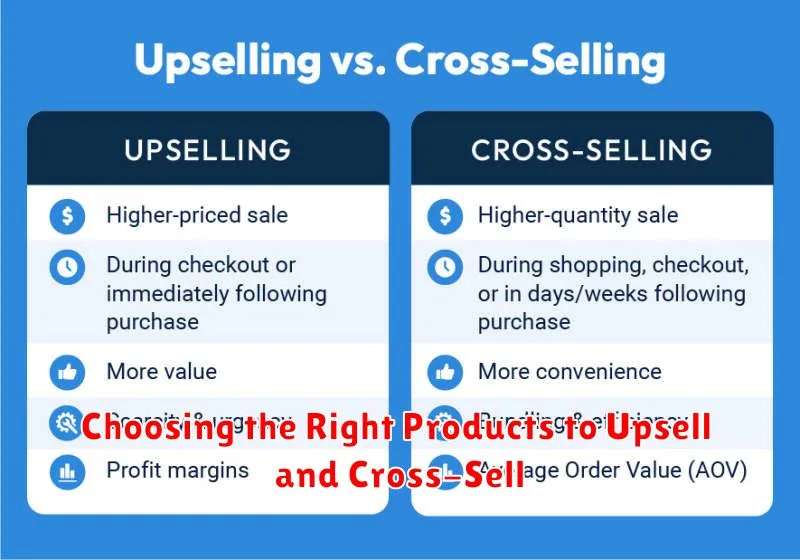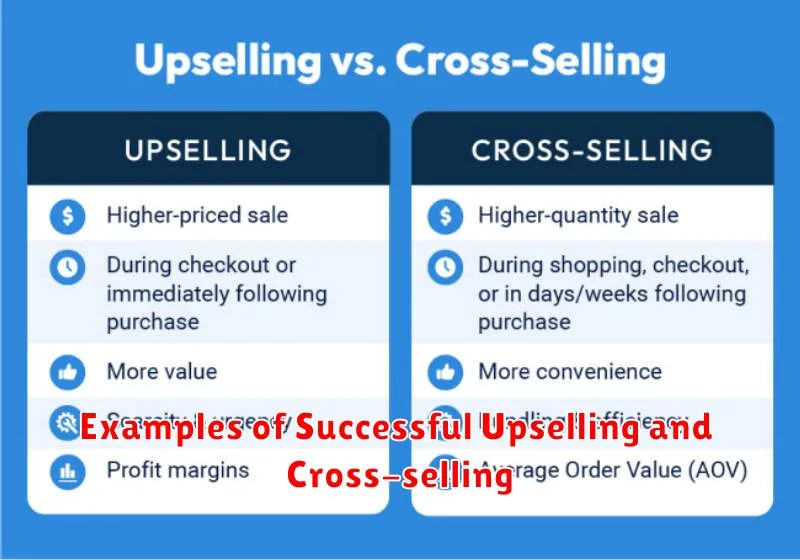In today’s competitive market, simply attracting customers isn’t enough. Businesses need to maximize the value of each transaction. Upselling and cross-selling are two powerful techniques that can significantly boost your sales and improve your bottom line. By strategically suggesting related products or higher-value options, you can encourage customers to spend more, increasing their average order value and fostering stronger customer relationships. Learning to implement effective upselling and cross-selling strategies is crucial for sustained business growth and increased profitability.
This article explores proven upselling and cross-selling techniques that can be readily implemented in any business. We’ll delve into the core principles of each technique, highlighting the key differences between upselling and cross-selling and providing practical examples of how to use them effectively. Whether you’re an e-commerce retailer, a service provider, or a brick-and-mortar store owner, this guide will equip you with the knowledge and tools necessary to boost your sales and cultivate lasting customer loyalty through smart upselling and cross-selling.
Understanding Upselling and Cross-Selling
Upselling and cross-selling are powerful sales techniques that encourage customers to purchase more, ultimately increasing your average order value. While often used interchangeably, they represent distinct strategies.
Upselling focuses on persuading a customer to buy a higher-end version of the product they’re already considering. This could involve suggesting a larger size, a more advanced model with additional features, or a premium package with added benefits. The key is to highlight the increased value and improved experience the upgraded product offers.
Cross-selling, on the other hand, involves suggesting related or complementary products to a customer’s existing purchase. This could include accessories, warranties, or other items that enhance the functionality or enjoyment of the primary product. The goal is to provide a complete solution and anticipate the customer’s potential needs.
Choosing the Right Products to Upsell and Cross-Sell

Selecting the right products for upselling and cross-selling is crucial for maximizing their effectiveness. A poor choice can deter customers and negatively impact their experience. Focus on products that genuinely enhance the original purchase.
For upselling, consider premium versions of the initially selected item, or products with enhanced features and benefits. The key is to offer a clear value proposition justifying the higher price. The upsell should feel like an upgrade, not a forced purchase.
Cross-selling requires identifying products that complement the original selection. These could be related accessories, bundles, or items frequently bought together. Analyze customer purchase history and product usage to understand these relationships. Relevance is key for successful cross-selling.
Avoid suggesting overly expensive upsells or irrelevant cross-sells. The offered products should align with the customer’s needs and budget. A well-chosen upsell or cross-sell should feel like a helpful suggestion, not a pushy sales tactic.
Effective Strategies for Upselling
Highlight the Value Proposition. Clearly communicate the added benefits of the higher-priced item. Focus on the improvements, additional features, or premium quality that justifies the increased cost. Avoid simply stating the price difference; instead, emphasize the value gained.
Create a Sense of Urgency. Limited-time offers or scarcity tactics can encourage customers to upgrade. Phrases like “limited stock” or “special offer for today only” can nudge customers toward a higher-priced option.
Use Product Comparisons. Provide a clear comparison chart or table highlighting the differences between various product tiers. This allows customers to easily see the advantages of upgrading and makes the decision-making process easier.
Personalize Recommendations. Leverage customer data and browsing history to suggest relevant upsells. Personalized recommendations demonstrate that you understand their needs and are offering a tailored solution.
Best Practices for Cross-Selling
Relevance is key. Offer products that genuinely complement the customer’s chosen item. A customer buying a laptop might appreciate a suggestion for a wireless mouse or laptop bag, not a garden gnome.
Timing is crucial. Present cross-sell offers after the customer has added an item to their cart, but before checkout. This ensures they’re already committed to a purchase and more receptive to additional suggestions.
Limit Choices. Offering too many options can overwhelm customers. Curate a small selection of relevant products, ideally no more than three.
Highlight Value. Clearly communicate the benefits of the cross-sell offer. Explain how the additional product enhances the initial purchase or solves a related problem. For example, “Protect your new laptop with this durable carrying case.”
Use Visuals. If possible, display images of the cross-sell products alongside the main item. Visual cues can be more persuasive than text alone.
Implementing Upselling and Cross-Selling in Your Online Store
Effectively integrating upselling and cross-selling into your online store requires a strategic approach. Consider these key implementation steps:
Product Page Placement
Position upsell and cross-sell offers strategically on product pages. Showcase “premium versions” or “better together” bundles directly alongside the primary product. Use clear and concise language to highlight the added value.
Shopping Cart Integration
The shopping cart presents another prime opportunity. Before checkout, suggest related items or upgraded options that complement the customer’s existing selections. Keep recommendations limited to avoid overwhelming the customer.
Personalized Recommendations
Leverage customer data and browsing history to personalize recommendations. Suggest items frequently purchased with the viewed product or offer upgrades based on previous purchases. This creates a more tailored experience.
Pop-up Notifications (Use Sparingly)
Employ exit-intent pop-ups judiciously. Offer a final, compelling upsell or cross-sell before a customer leaves your site. However, ensure these pop-ups are non-intrusive and easy to dismiss to avoid a negative user experience.
Measuring the Success of Your Upselling and Cross-Selling Efforts
Tracking the right metrics is crucial to understanding the effectiveness of your upselling and cross-selling strategies. Key Performance Indicators (KPIs) provide valuable insights into what’s working and what needs adjustment.
Here are some important KPIs to consider:
- Upsell/Cross-sell Conversion Rate: This measures the percentage of customers who accept an upsell or cross-sell offer. A higher conversion rate indicates successful strategies.
- Average Order Value (AOV): Track how upselling and cross-selling impact your AOV. A rise in AOV suggests that these techniques are effectively increasing sales per customer.
- Revenue Generated from Upselling/Cross-selling: This metric quantifies the direct financial impact of your efforts, demonstrating the return on investment (ROI).
- Customer Lifetime Value (CLTV): While not a direct measure, successful upselling and cross-selling contribute to increased CLTV by fostering stronger customer relationships and driving repeat purchases.
By regularly monitoring these KPIs, you can refine your approach, optimize offers, and maximize the impact of your upselling and cross-selling initiatives.
Common Mistakes to Avoid
While upselling and cross-selling are powerful techniques, misapplication can negatively impact customer experience and sales. Avoid these common pitfalls for better results.
Being Too Pushy
Aggressive upselling or cross-selling can alienate customers. Focus on offering genuine value and relevant suggestions, rather than pressuring them into additional purchases. Respect their decision if they decline.
Irrelevant Recommendations
Upsells and cross-sells should complement the initial purchase. Relevance is key. Offering unrelated products confuses customers and reduces the likelihood of conversion.
Ignoring Customer Segmentation
Different customers have different needs. Tailor your offers based on their purchase history, browsing behavior, and demographics. Personalization enhances the customer experience and improves the effectiveness of your efforts.
Overcomplicating the Offer
Keep the upsell or cross-sell offer simple and straightforward. A confusing or convoluted offer will likely be ignored. Clearly communicate the value proposition and make it easy for the customer to accept.
Examples of Successful Upselling and Cross-selling

Fast Food Combo Upselling: A customer orders a burger. The cashier suggests upgrading to a combo meal that includes fries and a drink for a slightly higher price. This leverages the customer’s initial purchase and increases the order value.
Software Subscription Cross-selling: A customer purchases basic photo editing software. The company then offers them a cross-sell opportunity for a photography tutorial package to enhance their skills and fully utilize the software’s features. This complements the original purchase and adds value for the customer.
Electronics Warranty Upselling: A customer is about to buy a new television. The salesperson highlights the benefits of an extended warranty, protecting their investment against potential issues and offering peace of mind. This addresses a potential customer concern and increases the purchase value.
E-commerce Product Recommendations: An online shopper adds a pair of shoes to their cart. The website’s algorithm suggests matching socks or a shoe cleaning kit. This personalized cross-sell caters to the customer’s current purchase and encourages additional spending.
Tools and Technologies to Help You Upsell and Cross-sell
Several tools and technologies can streamline your upselling and cross-selling processes, making them more effective and efficient. Leveraging these can significantly improve your sales performance.
CRM Systems
Customer Relationship Management (CRM) systems are invaluable. They provide a centralized view of customer interactions, purchase history, and preferences, enabling personalized upsell and cross-sell offers. CRM data allows you to identify opportunities and tailor recommendations to individual customer needs.
E-commerce Platforms
Many e-commerce platforms offer built-in features to facilitate upselling and cross-selling. These often include product recommendation engines that suggest related items during browsing or at checkout. Some platforms also allow for personalized promotions based on customer segments and behavior.
Marketing Automation Software
Marketing automation tools can automate upselling and cross-selling campaigns through targeted email marketing and personalized website experiences. These tools allow you to trigger specific offers based on customer actions, such as browsing history or abandoned carts.
Analytics Dashboards
Monitoring performance is key. Analytics dashboards help you track key metrics such as upsell/cross-sell conversion rates, average order value, and revenue generated through these strategies. This data informs optimization efforts and allows you to refine your approach over time.

